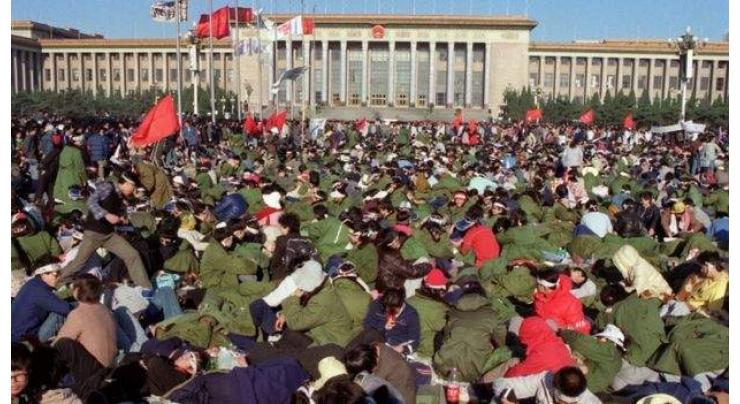
Tiananmen Square Protests In 1989
Mohammad Ali (@ChaudhryMAli88) Published June 04, 2019 | 04:20 PM

June 4 marks 30 years since the 1989 Tiananmen Square massacre when the Chinese authorities brutally suppressed peaceful protests led by students demanding democratic reforms
MOSCOW (UrduPoint News / Sputnik - 04th June, 2019) June 4 marks 30 years since the 1989 Tiananmen Square massacre when the Chinese authorities brutally suppressed peaceful protests led by students demanding democratic reforms.
According to official data from China, 241 people died in the crackdown, and about 7,000 people were injured. Human rights activists, however, have claimed that the death toll is in the thousands.
The Tiananmen Square anti-government protests were caused by a lack of social and political democratization and the monopoly of the Chinese Communist Party's (CCP) on political power, given the active liberalization of the country's economic life. Reports on perestroika in the Soviet Union and democratic changes in socialist countries played a significant role in stoking dissatisfaction with the Chinese government's policies.
On April 15, 1989, the day when Hu Yaobang, a supporter of China's democratization and former CCP General Secretary, died, hundreds of Beijing students gathered on university campuses and Tiananmen Square, the central square of Beijing, to honor his memory.
On April 23, the Beijing Independent Student Union was established. Students demanded the democratization of political life, media freedom and for corruption within the party to be eliminated.
Three days later, with the approval of Deng Xiaoping, the then-chairman of China's Central Military Commission, the party press denounced the students as counterrevolutionaries. However, in early May, Zhao Ziyang, Hu Yaobang's successor as CCP General Secretary, described the student movement as patriotic and invited the protesters to engage in dialogue.
On May 13, about 300,000 protesters announced the beginning of a hunger strike in Tiananmen Square in a bid to get the government to meet their demands. Members of the newly established Beijing Workers' Autonomous Federation, grass-roots parties representatives and Komsomol organizations joined the protesters, and the demonstrations started to spread to more than 400 cities nationwide.
The protests on Tiananmen Square took place on the eve of Soviet leader Mikhail Gorbachev's state visit to China, which was to be held from May 15-18 with the purpose of normalizing relations between the two countries.
Gorbachev was scheduled to lay a wreath at the Monument to the People's Heroes in the center of Beijing. The students were ready to greet him and even made banners in Russian saying "Democracy is Our Common Dream."
However, Gorbachev did not come to Tiananmen Square, and, asked about his attitude to the protests, told the media that this was an "internal affair."
Soon, peaceful protests in several large cities turned into riots. The Chinese capital was paralyzed, with protesters using weapons to kill police officers and soldiers, and burning buses and shops.
From May 17-19, the CCP leaders, despite resistance from Zhao Ziyang, decided to bring troops into the city.
On the morning of June 3, 1989, the Chinese People's Liberation Army were stopped by the protesters, but on the evening of the same day, army units with tanks were brought to the square. A peaceful protest gave way to a violent armed conflict. Protesters set tanks and armored vehicles on fire. The soldiers opened indiscriminate fire on the demonstrators.
The protests in Tiananmen Square were suppressed the following day. In Shanghai, however, the protests continued until June 7, but Jiang Zemin, who headed the CCP's city committee, managed to bring the situation under control without resorting to violence. In Chengdu, the protests were suppressed by troops by June 6.
The exact number of Tiananmen Square victims has never been confirmed.
The crackdown was followed by a wave of arrests. More than 1,500 people were arrested, and eight people were sentenced to death. Many protesters were deprived of their Chinese citizenship and deported. Some of the protesters managed to flee the country, including to Hong Kong, a British colony at the time.
In the West, the events are seen as "protests for democracy," while Beijing officially considers them a "counterrevolutionary insurgency."
In 2004, then-Chinese President Hu Jintao stated that Beijing did not intend to change its attitude toward the 1989 events. He noted that the measures taken at that time had played a "decisive role" in China's successful economic growth in the following years.
Related Topics
Recent Stories

Tennis: ATP Barcelona Open results - 1st update

Swiatek's perfect 10 in Stuttgart as Vondrousova stuns Sabalenka

Arandu's roads closed due to flooding

Oil tanker catches fire in Islamabad’s Blue Area

Pakistan committed to ensure safety of foreign nationals: FO

Tennis: WTA Stuttgart results - 1st update

Four passengers injured as train hit an empty vehicle

Over- speeding bus crushed to death two bike riders

Turkey's Freedom Flotilla ready to set sail for Gaza

French teen dies from heart failure after knife attack near school

Iranians appear unfazed by Isfahan blasts

UAF celebrates Int'l Chinese Language Day
More Stories From World
-
Togo lawmakers approve contested political reform
5 hours ago -
NATO must choose 'whether we indeed are allies': Zelensky
5 hours ago -
US House to vote on Ukraine, Israel, Taiwan aid package
5 hours ago -
Calls for calm after reported Israeli strike on Iran
5 hours ago -
IMF calls on EU to deepen single market integration to boost growth
5 hours ago -
Second Ecuadoran mayor killed ahead of anti-crime referendum: police
5 hours ago
-
Oil, gas drilling blocked in Alaska wilds as Biden seeks green cred
6 hours ago -
Man sets self on fire outside Trump trial
6 hours ago -

Turkey's Freedom Flotilla ready to set sail for Gaza
7 hours ago -

French teen dies from heart failure after knife attack near school
7 hours ago -

Iranians appear unfazed by Isfahan blasts
8 hours ago -

Ecuador mayor killed ahead of anti-crime referendum: police
8 hours ago



